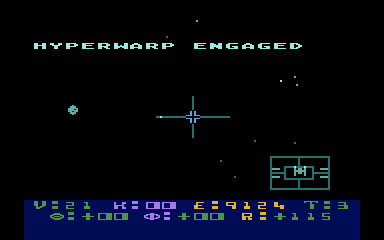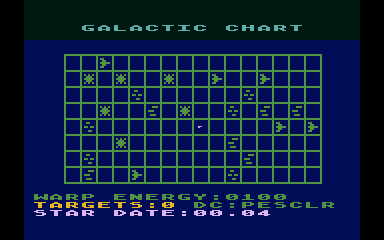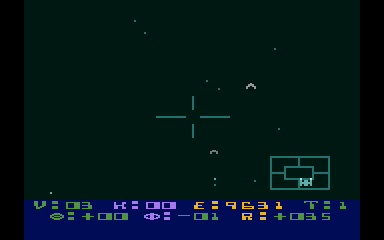
Photo 1: The view from the bridge of the Star Raiders ship during a hyperspace jump. A static photo cannot do justice to the excitement you feel as stars streak by prior to the jump.
| At a Glance | |||||||||||||||||||
|---|---|---|---|---|---|---|---|---|---|---|---|---|---|---|---|---|---|---|---|
|
|
||||||||||||||||||
What can you say about a game that takes your breath away? There are not enough superlatives to describe Star Raiders. Just as the VisiCalc software package from Personal Software has enticed many people into buying Apple II computers, I'm sure that the Star Raiders software cartridge from Atari Inc has sold its share of Atari 400 and 800 computers.

Photo 1:
The view from the bridge of the Star Raiders ship during a hyperspace jump. A
static photo cannot do justice to the excitement you feel as stars streak by prior
to the jump.
What is Star Raiders? It's a video arcade game that isn't hungry for quarters. I first saw Star Raiders at the West Coast Computer Faire in May 1979, and in the two years that have passed since the first public viewing of the game, no one---I repeat, no one---has created either a home-computer game or a coin-operated video game that is better than Star Raiders. (This fact is even more surprising when you consider the speed with which new standards are set in this industry.)
For the people who haven't seen Star Raiders in action, I'll attempt a brief description. Star Raiders is loosely modeled on the "Star Trek"-type game that has been running on micro- and larger computers for the past eight years. You, as commander of a starship, must search out and destroy all enemy spaceships in the galaxy (which is subdivided into a rectangular array of units called "sectors"). Of course you have only a certain amount of energy, and when you fight an enemy ship that is in the sector you occupy, it can fight back and damage your ship.

Photo 2:
The Star Raiders Galactic Chart. Each square represents a sector of space. The star
symbols represent sectors containing starbases; all other squares marked with symbols
represent sectors containing Zylon enemy ships. Your ship is located in the square near
the center, marked by a small dot.
Star Raiders is a descendant of this kind of game in the same way that the new pocket computers are descendants of a four-function mechanical adding machine. The many innovations in Star Raiders make you feel that you are actually piloting the spaceship instead of just typing in commands (and endlessly pressing the ubiquitous RETURN key).
Star Raiders has color, sound, and joystick input to make the game more realistic, but the feature that gives it life is its real-time animation. When you patrol a sector, you see a field of stars passing you in all directions, as if you were actually moving through a three-dimensional field of stars. When you steer the ship using your joystick, the stars outside your ship veer realistically in the opposite direction. Enemy ships (called Zylons) appear from above or below, receding in size as they speed past. A battle claxon sounds when you enter a sector containing enemy ships. Attacking Zylons shoot balls of energy at your ship; if they hit, your shields flicker and you hear a destructive crash. And the hyperspace effect (used to move you from one sector to another) must be seen to be believed!

Photo 3:
The view from the bridge during combat. "Star Trek" games were never like this!
When you occupy the same sector as enemy ships (here, top and bottom center) their size
will increase and decrease as you move toward or away from them.
I could continue to describe the intricacies of Star Raiders, but words cannot evoke the sensation of actually playing the game. To Doug Neubauer of Atari, who wrote Star Raiders, my unbounded thanks. To all software vendors, this is the game you have to surpass to get our attention. And to Atari, I can only say that if you offer us games like this, we can't refuse. ¤